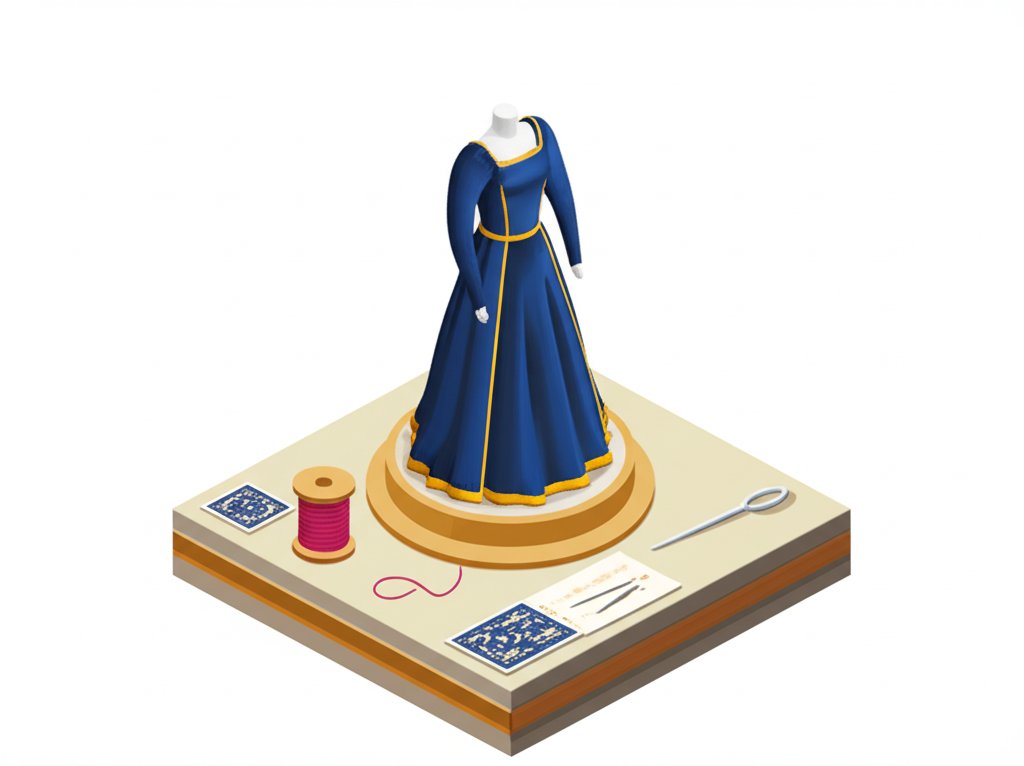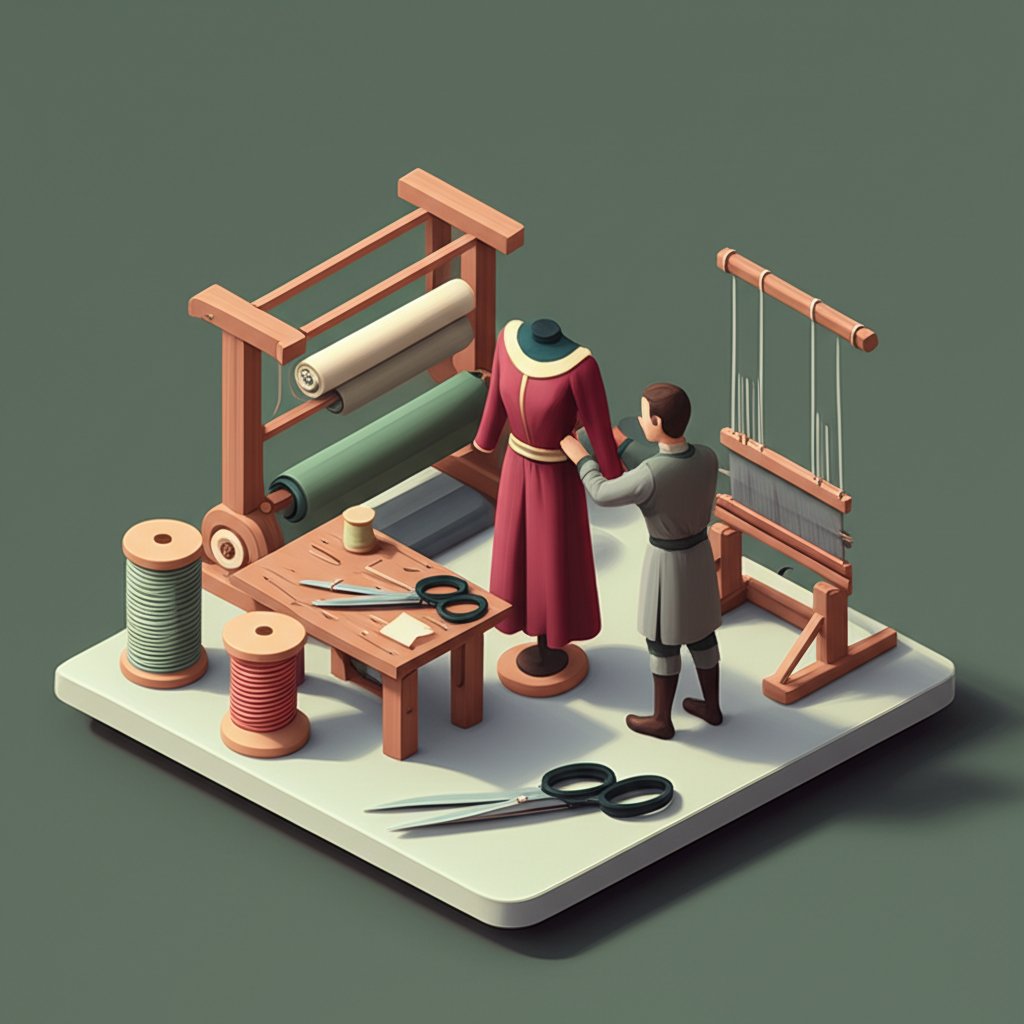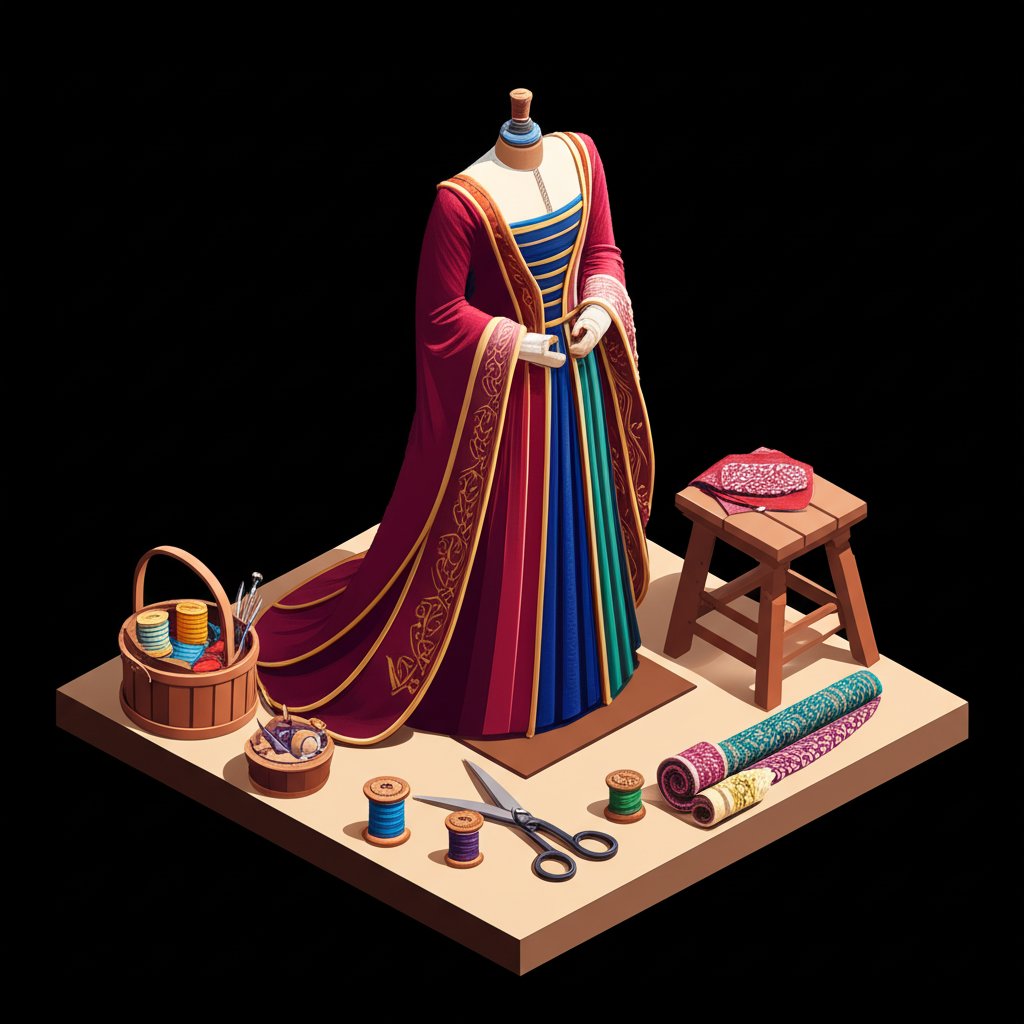Imagine the bustling streets of a medieval town, vibrant with color and sound. What medieval clothing springs to mind? For many, it’s the image of a lady, elegantly draped in a long, fitted dress with impossibly tight sleeves. This iconic silhouette, far from a mere romanticized fantasy, points directly to one of the most significant garments of the era: the cotehardie. But what exactly was this pivotal piece of 14th century fashion? More than just a simple medieval gown, the cotehardie was a testament to evolving tailoring, social status, and personal expression. This comprehensive guide will unearth the full story of the cotehardie, from its humble origins as the cotte to its reign as a high-fashion staple, debunking myths and offering an unparalleled deep dive into a truly revolutionary garment. Prepare to discover the intricate secrets hidden within the stitches of the 14th-century cotehardie. (And for the record, it’s pronounced [kot-ar-dee]).
The Cotehardie Defined: A New Era in Medieval Clothing

The cotehardie stands as an emblem of a paradigm shift in medieval clothing. Before its emergence, garments were largely loose, draped or simply cut, obscuring the body’s form. The 14th century, however, marked a pivotal moment, ushering in an era of tailoring and fit. The cotehardie was at the forefront of this revolution, introducing a fitted silhouette that celebrated the human form like never before in the Middle Ages. Its name, derived from Old French “cote” (coat/tunic) and “hardie” (bold/hardy), hints at its dual nature: practical yet stylish, robust yet elegant.
Origins: From the Humble Cotte to a Fashion Statement
To understand the cotehardie, we must first look to its ancestor, the cotte. The cotte was the foundational garment for both men and women throughout the early and high medieval periods. Essentially a simple tunic, it served as the innermost layer of clothing, worn directly against the skin or over a lightweight chemise. It was loose-fitting, practical, and ubiquitous, the medieval equivalent of a basic undershirt or smock.
As the 14th century dawned, a desire for more closely fitting garments grew. Tailors, with improved techniques and tools, began to cut fabric with greater precision, shaping garments to the torso. This evolution saw the cotte transform. Seams, once simple, became structural, designed to hug the body. The formerly anonymous cotte began to acquire a new, more distinctive character, culminating in the cotehardie. This wasn’t merely an upgrade; it was a re-invention, turning a utilitarian undergarment into a potential outer display of wealth and taste, marking a significant turning point in medieval clothing.
Decoding the Name: What “Cotehardie” Truly Means
The term “cotehardie” itself provides valuable insight into the garment’s nature. As mentioned, it combines “cote” (tunic/coat) with “hardie” (bold, hardy, sturdy). This suggests a garment that was more substantial and perhaps more formally structured than the simple cotte. It was a “bold tunic” – bold not just in its construction but also in its statement. It was a garment that dared to be fitted, to show the body underneath, a distinct departure from previous, more modest styles.
This bold new approach was a hallmark of 14th century fashion. The cotehardie wasn’t just clothing; it was a carefully constructed piece that required skilled tailoring, making it a symbol of burgeoning sartorial sophistication. Its name perfectly encapsulates this shift, signifying a garment that was both practical for daily wear for some, and a striking fashion statement for others, differentiating it significantly from its plainer predecessor.
The move towards fitted garments like the cotehardie represented a significant development in tailoring, reflecting broader trends in the history of dressmaking and the evolution of garment construction techniques.
Anatomical Breakdown: Key Features of the 14th Century Cotehardie
The cotehardie wasn’t a single, uniform style but a family of garments sharing core characteristics that defined 14th century fashion. Understanding its “anatomy” reveals the ingenuity of medieval tailoring and the societal messages encoded in its design.
The Tailored Torso: Bodices, Lacing, and Fit
The most defining feature of a cotehardie was its fitted torso. Unlike earlier, looser tunics, the cotehardie was cut to closely follow the lines of the wearer’s body from the shoulders to the hips. For women, this meant a snug bodice that accentuated the waist and bust. For men, it created a sleek, athletic profile.
This remarkable fit was achieved through sophisticated pattern cutting and, crucially, a variety of fastenings. Buttons, often numbering in the dozens or even hundreds, were a popular choice for both men and women, running down the front, back, or sides of the garment. These tiny, functional works of art, made from metal, bone, or fabric, were not just practical but also highly decorative, especially when arranged in tight rows. Lacing, another common fastening, offered adjustability and could be found along the sides, front, or back, sometimes hidden, sometimes openly displayed to enhance the garment’s snug fit. The precision of these fastenings was a hallmark of the 14th century fashion aesthetic, allowing for a tailored look previously unseen in medieval clothing.
Sleeves of Distinction: From Tight to Trailing (Tippets)
Sleeves on a cotehardie were often as distinctive as the torso. Typically, they were long and close-fitting, extending right down to the wrist. This tight fit was usually achieved with numerous buttons running from the elbow down, allowing the wearer to slip their hand through the narrow opening.
A particularly fashionable feature for women’s cotehardies (and sometimes men’s) in the mid-to-late 14th century was the adornment of “tippets” or “streamers.” These long, decorative strips of fabric would hang from the elbow, often contrasting in color or material with the main garment. Some could be extremely long, even reaching the ground, and were purely for display, signaling the wearer’s status and adherence to the latest 14th century fashion. These elegant extensions transformed what might have been a simple sleeve into a dramatic and visually striking element of the medieval gown.
Skirt Silhouettes: Length, Volume, and Movement in the Medieval Gown
While men’s cotehardies were almost universally short, typically hip-length or mid-thigh, the skirt of a woman’s cotehardie offered a wider range of styles. It transitioned from the fitted bodice, often flaring out to create a full, elegant skirt. The length could vary, from ankle-length for practical wear to sweeping floor-length for formal occasions or for women of higher status.
The volume of the skirt was achieved through strategic fabric panels, often triangular “gores” inserted into the seams, allowing for a graceful drape and movement. This flowing lower half, combined with the tightly fitted bodice and sleeves, created the iconic silhouette of the medieval gown that is often depicted in period art. The choice of skirt length and fullness was not merely aesthetic; it often reflected social standing and the occasion, with more elaborate, longer skirts reserved for the wealthy and nobility, making the cotehardie a versatile piece of medieval clothing.
Fabrics, Colors, and Embellishments: A Display of Wealth
The materials and adornments of a cotehardie were crucial indicators of the wearer’s wealth and social standing, making it a vivid expression of 14th century fashion.
- Fabrics: While peasants might wear cotehardies of coarse wool or linen, the nobility and affluent merchants flaunted garments made from fine wool, luxurious silks (often imported from Italy or the Byzantine Empire), velvets, and even brocades. The quality and origin of the fabric spoke volumes.
- Colors: Dyes were expensive and complex to produce. Bright, saturated colors like deep reds (from madder or kermes), rich blues (from woad or indigo), and vibrant greens were highly prized. Sumptuary laws sometimes attempted to restrict certain colors or materials to specific social classes, although these laws were often flouted.
- Embellishments: Beyond the decorative buttons and tippets, cotehardies could be further embellished with intricate embroidery in silk or gold thread, precious furs (like ermine or squirrel lining), or even small jewels. A rich belt worn at the waist was a common accessory, further enhancing the silhouette and providing another opportunity for display.
These elements transformed the cotehardie from simple attire into a walking declaration of status, reflecting the dynamic social structures of the 14th century through the very threads of medieval clothing.
The Cotehardie in 14th Century Fashion and Society
The cotehardie was more than just an item of medieval clothing; it was a sartorial mirror reflecting the intricate social hierarchy, gender roles, and evolving aesthetic tastes of the 14th century.
Gendered Styles: Men’s Short “Jackets” vs. Women’s Elegant Gowns
One of the most striking aspects of the cotehardie was its distinct gendered presentation, a clear example of how 14th century fashion differentiated between men and women.
- Men’s Cotehardies: For men, the cotehardie was typically a shorter, fitted garment, often hip-length or mid-thigh. It resembled a modern jacket or doublet, sometimes padded for a more robust silhouette. These shorter versions were practical for active men and were usually worn over a linen shirt, paired with tight-fitting hose (leggings). The shorter length also began to reveal more of the leg, a new stylistic development that was sometimes seen as controversial but quickly became fashionable.
- Women’s Cotehardies: For women, the cotehardie typically extended into a full, often floor-length skirt, creating an elegant medieval gown. While the bodice remained tightly fitted, the flowing skirt provided grace and modesty. This longer style, often layered over a contrasting cotte or kirtle, became synonymous with feminine elegance and was adapted to various social settings, from daily life to courtly events.
This divergence showcased how the core concept of a fitted garment could be adapted to suit prevailing ideals of male and female appearance, solidifying the cotehardie’s place in the diverse landscape of medieval clothing.
A Status Symbol: Dressing the Social Hierarchy
The cotehardie was a powerful visual cue for social ranking. The materials, cut, and embellishments directly communicated the wearer’s position within medieval society, making it a key element of 14th century fashion communication.
- Nobility and Wealthy Merchants: For the elite, cotehardies were crafted from the finest silks, velvets, and wools, dyed in brilliant, costly colors. They were often adorned with elaborate embroidery, precious furs, and sometimes even jewels. The sheer volume of fabric in a wealthy woman’s medieval gown, or the intricate tailoring of a nobleman’s cotehardie, spoke volumes about their access to resources and skilled labor.
- Artisans and Gentry: Those of middling status would wear cotehardies made from good quality wool, perhaps in more subdued colors, but still well-fitted and clean. While lacking the extravagant embellishments of the nobility, their garments would still reflect a respectable standing.
- Peasants and Laborers: For the lower classes, a cotehardie would be a simple, durable garment, likely made from undyed or naturally colored coarse wool or linen. It would be practical and hard-wearing, often serving as their primary outer layer, though still reflecting the era’s fitted aesthetic to a degree, albeit in a more basic form.
The subtle and overt differences in cotehardie styles thus provided a quick visual shorthand for identifying a person’s place in the rigid social structure of the time, making it an indispensable part of medieval clothing.
Regional Variations and Evolving Trends
Just like modern fashion, 14th century fashion was not static or monolithic. The cotehardie saw considerable regional variations across Europe and evolved throughout the century.
In Italy, the fit might be even snugger, with bold patterns. In Northern Europe, particularly England and France, the silhouette might be slightly more modest, though still fitted. The sleeves, necklines, and skirt fullness could also fluctuate with changing tastes. For instance, early 14th-century cotehardies might have been less aggressively fitted than those from the latter half of the century, which often featured elaborate rows of buttons and more dramatic tippets.
Moreover, the cotehardie itself paved the way for subsequent fashion innovations. Its emphasis on tailoring and body-conforming shapes directly influenced the development of later garments like the doublet for men and fitted gowns for women in the 15th century. It was a garment constantly in flux, adapting to new social demands and aesthetic preferences, reflecting the dynamic nature of medieval clothing.
Kirtle, Cotte, and Cotehardie: Unraveling the Terminology Confusion

One of the most persistent challenges in studying medieval clothing, particularly 14th century fashion, is the often-confusing and fluid terminology. The terms “kirtle,” “cotte,” and “cotehardie” are frequently used interchangeably, yet costume historians recognize nuanced distinctions that are vital for accuracy.
The Cotte: Foundation of Medieval Dress
As established, the cotte was the fundamental, usually loose, tunic-like garment worn close to the body. It predates the distinct tailoring of the 14th century and remained a basic layer for all social classes throughout the Middle Ages, often serving as an undergarment beneath more elaborate outer layers. It was functional, modest, and the essential starting point for any medieval ensemble. Its simplicity is key to understanding its place in the lineage of medieval clothing.
The Kirtle: A Versatile Under or Outer Garment
The kirtle is perhaps the most vexing of the three terms. Generally, scholars believe a kirtle was a fitted garment, similar in many ways to a cotehardie, often worn by women. It could serve as an undergarment (worn beneath an outermost gown) or as an outer garment, especially for less formal occasions or for working women. Kirtles were typically simpler in ornamentation than a high-fashion cotehardie and might not feature the very latest cutting-edge embellishments like extensive rows of buttons or dramatic tippets, though they were still fitted garments.
The confusion arises because, in some contexts, “kirtle” and “cotehardie” might have referred to the same garment, or the terms were used with regional and temporal variations. It’s plausible that a kirtle was essentially a simpler, less ornate, or slightly less fashion-forward version of a cotehardie, especially for women, or a garment that had not yet fully incorporated all the specific features associated with the “hardie” aspect.
Distinct or Fluid? Historical Debate and Modern Understanding
The precise distinction between kirtle and cotehardie remains a subject of ongoing academic debate among costume historians. There isn’t a single, universally agreed-upon definition that applies across all regions and all decades of the 14th century fashion landscape.
- The “Evolutionary” View: Many scholars view the cotte evolving into the kirtle, which then further developed into the more fashionable and overtly tailored cotehardie. In this view, the kirtle represents an intermediate stage of increasing fit and complexity.
- The “Functional/Stylistic” View: Another perspective suggests that the kirtle was primarily a functional, often less ornamented, fitted under- or outer garment, while the cotehardie was specifically the high-fashion, elaborately tailored, and often richly embellished version.
- The “Regional/Temporal” View: It’s also recognized that names for garments could vary significantly from one region to another (e.g., France vs. England) and change over time. What was called a “kirtle” in one place might be a “cotehardie” elsewhere, or the terms simply overlapped considerably in everyday usage.
For the purpose of identifying a medieval gown in art or text, looking for the specific features of tight sleeves with buttons, a very closely fitted bodice, and a distinct flare for the skirt helps identify a classic cotehardie. However, it’s crucial to acknowledge the fluidity of medieval terminology and appreciate that our modern attempts to categorize can sometimes oversimplify the reality of medieval clothing.
Beyond the Hype: Debunking Common Cotehardie Myths
The cotehardie, despite its historical prominence, is often subject to modern misconceptions, fueled by romanticized depictions and a lack of detailed understanding of 14th century fashion. To truly comprehend this garment, we must separate fact from fiction.
The “Uniform” Myth: Diversity in 14th Century Fashion
Perhaps the most pervasive myth is that the cotehardie was a single, unchanging garment, akin to a medieval uniform. This is far from the truth. As discussed, the cotehardie was a dynamic garment, constantly evolving and reflecting diverse tastes. It was not a static medieval gown but a spectrum of styles.
- Beyond the “Long Gown”: While long, flowing women’s cotehardies are iconic, men’s versions were short, jacket-like garments. Even women’s styles varied in length, fullness, and sleeve treatment. The notion of only a long, flowing buttoned gown is a simplification.
- Functionality vs. Fashion: A peasant’s cotehardie was durable and practical, made for labor. A noblewoman’s was exquisite, designed for display. These two garments, while sharing the underlying principle of a fitted shape, were vastly different in appearance, materials, and purpose, highlighting the immense diversity within medieval clothing.
- Evolving Trends: Within the 14th century itself, the cotehardie adapted. Early styles might have been less dramatically fitted than later ones, and features like tippets came into and went out of vogue. This adaptability underscores that 14th century fashion was as susceptible to trends as any other era.
From Art to Reality: Interpreting Visual Evidence
Another significant challenge is relying solely on medieval artwork for an accurate depiction of the cotehardie. While invaluable, illuminated manuscripts, tomb effigies, and paintings are not always precise photographic records.
- Artistic License: Artists often prioritized symbolism, religious narrative, or idealized beauty over hyper-realistic portrayal of medieval clothing. A garment might be simplified, exaggerated, or depicted in a stylized manner to fit the artistic conventions of the time. Proportions could be distorted, and details omitted or altered.
- Context Matters: The social status of the person depicted, the purpose of the artwork (e.g., a devotional image vs. a portrait), and regional artistic styles all influence how a cotehardie might appear. A wealthy patron would likely commission an image showing them in the latest, most flattering 14th century fashion, which might not represent everyday wear for everyone.
- Missing Pieces: Surviving garments from the 14th century are exceedingly rare due to the perishable nature of textiles. This means much of our understanding is based on interpreting fragmented visual evidence and written descriptions, making reconstruction a challenging but rewarding puzzle.
Therefore, while medieval art is our window into the past, it must be interpreted critically, acknowledging its limitations. The “classic” image of the cotehardie might well be a composite, romanticized notion informed by a selective reading of historical sources, prompting ongoing research to refine our understanding of this truly pivotal piece of medieval clothing.
Conclusion: The Enduring Legacy of the Cotehardie in Medieval Clothing
The cotehardie stands as an undeniable turning point in the history of medieval clothing and a cornerstone of 14th century fashion. Far from a simple medieval gown, it represented a revolutionary shift towards tailored garments that embraced and displayed the human form. From its humble beginnings as the cotte, it evolved into a sophisticated garment distinguished by its fitted bodice, tightly buttoned sleeves, and varied skirt lengths, reflecting the wearer’s social status with every stitch and embellishment.
We’ve delved into its intricate anatomy, explored its diverse manifestations for men and women, and navigated the often-confusing terminology surrounding “kirtle” and “cotte.” By debunking common myths and critically examining historical evidence, we gain a far richer and more nuanced appreciation for this extraordinary garment. The cotehardie was not just a piece of fabric; it was a complex social statement, a canvas for artistic expression, and a testament to the evolving skills of medieval tailors.
Its influence echoed through subsequent centuries, laying the foundational principles for modern tailoring. The next time you encounter an image or mention of a cotehardie, pause. Recognize the sophisticated tailoring, the delicate buttons, the rich materials, and the profound social messages woven into its very fabric. It is a garment that continues to unveil the fascinating secrets of a bygone era, reminding us that fashion, then as now, is a powerful mirror to society.
FAQ Section: Your Cotehardie Questions Answered
Q1: How do you pronounce “Cotehardie”?
A1: The most accepted pronunciation is [kot-ar-dee]. Think “coat hardy,” but blend the sounds smoothly, with a soft “t” and a rolling “r.”
Q2: What is the main difference between a Cotehardie and a Cotte?
A2: The cotte was a foundational, generally loose, tunic-like garment worn close to the body. The cotehardie evolved from the cotte, distinguished by its fitted and tailored silhouette, often featuring extensive buttoning, lacing, and more elaborate embellishments, making it a distinct piece of 14th century fashion.
Q3: Was the Cotehardie worn by both men and women?
A3: Yes, the cotehardie was worn by both men and women. Men typically wore shorter, hip-length or mid-thigh versions, resembling a fitted jacket, often paired with hose. Women’s cotehardies were generally longer, forming a fitted medieval gown with a full skirt.
Q4: What materials were Cotehardies made from?
A4: The materials varied greatly by social class. Wealthy individuals wore cotehardies of fine wool, silk, velvet, brocade, and often lined with fur. Lower classes made do with coarser wool and linen, reflecting the diverse nature of medieval clothing.
Q5: How did the Cotehardie reflect social status?
A5: Social status was evident in the quality of the fabric (e.g., silk vs. coarse wool), the vibrancy and cost of the dyes, the number and material of buttons, the presence of tippets, and elaborate embroidery or fur linings. A highly decorated and well-tailored cotehardie was a clear sign of wealth and nobility in 14th century fashion.
Q6: What is a “kirtle” and how does it relate to the Cotehardie?
A6: A kirtle was also a fitted garment, similar to a cotehardie, often worn by women. The distinction is debated among historians, but generally, a kirtle might be considered a simpler, perhaps less ornate or fashion-forward, fitted garment, often worn as an underlayer or for less formal occasions, while the cotehardie represented the peak of 14th century fashion with its specific, elaborate tailoring features.
Q7: Why is 14th century fashion significant for the Cotehardie?
A7: The 14th century was pivotal because it saw a revolution in tailoring, moving away from draped, loose garments to fitted, body-conscious styles. The cotehardie was a prime example and driver of this shift, defining the silhouette of the era and heavily influencing future medieval clothing trends.










